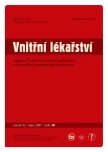The benefit from ibandronate in the treatment of postmenopausal osteoporosis
Authors:
Z. Málek
Authors‘ workplace:
Osteocentrum MEDIEKOS Labor s. r. o. Zlín, ředitel MUDr. Pavel Novosad
Published in:
Vnitř Lék 2007; 53(10): 1114-1118
Category:
Reviews
Overview
Apart from other factors, the treatment of osteoporosis is limited by a narrow range of applicable drugs. Ibandronate, forming part of the aminobisphosphonate group, which was launched in clinical practice in 2005, has extended the range of treatment options. It allows for intermittent dosage in 1-month (oral form) or 3-month (intravenous form) intervals, whilst the high efficiency of treatment and good safety profile are preserved. Intermittent dosage significantly improves the adherence of patients to treatment, which has, apart from other advantages, a positive effect on cost efficiency of treatment. In addition, oscillation in bone remodelation in the course of intermittent ibandronate treatment might have a positive effect on the physiology of bone tissue, thus reducing some risks associated with bisphosphonate treatment.
Keywords:
osteoporosis – ibandronate – bone remodelation – osteoporotic fracture
Sources
1. Dennison E, Cooper C. Epidemiology of osteoporotic fractures. Hormonal Research 2000; 54(Suppl 1): 58-63.
2. Kanis JA, Johnell O, Oden A et al. Long-term risk of osteoporotic fracture in Malmö. Osteoporos Int 2000; 11 : 669-674.
3. Kanis JA, Johnell O. Requirements for DXA for the management of osteoporosis in Europe. Osteoporosis Int 2005; 16 : 229-238.
4. Cummings SR, Black DM, Thompson DE et al. Effect of alendronate on risk of fracture in women with low bone density but without vertebral fractures: results from the Fracture Intervention Trial. JAMA 1998; 280 : 77-82.
5. Pols HA, Felsenberg D, Hanley DA et al. Multinational, placebo-controlled, randomized trial of the effects of alendronate on bone density and fracture risk in postmenopausal women with low bone mass: results of the FOSIT study. Foxamax International Trial Study Group. Osteoporos Int 1999; 9 : 461-468.
6. Harris ST, Watts NB, Genant HK et al. Effects of risedronate treatment on vertebral and nonvertebral fractures in women with postmenopausal osteoporosis: a randomized controlled trial. Vertebral Efficacy With Risedronate Therapy (VERT) Study Group. JAMA 1999; 282 : 1344-1352.
7. Caro J, Isak KJ, Huybrechts KF. Clinical and economic impact of adherence to osteoporosis medication (abstract PL6). Osteoporos Int 2003; 14(Suppl 7): S2-S3.
8. Tosteson AN, Grove MR, Hammond CS et al. Early discontinuation of treatment for osteoporosis. Am J Med 2003; 115 : 209-216
9. Rizzoli R, Greenspan SL, Bone G 3rd et al. Two-year results of once-weekly administration of alendronate 70 mg for the treatment of postmenopausal osteoporosis. J Bone Miner Res 2002; 17 : 1988-1996.
10. Leu CT, Luegmayr E, Freedman LP et al. Relatice binding affinities of bisphosponates for human bone. Bone 2004; 34(Suppl 1): S62.
11. Green JT Bisphoshponates: preclinical review. Onkologist 2004; 9(Suppl 4): 3-13.
12. Epstein S, Zaidi M Biological properties and mechanism of action of ibandronate: Application to the treatment of osteoporosis. Bone 2005; 37 : 433-440.
13. Frith JC, Monkkonen J, Blackburn GM et al. Clodronate and liposome-encapsulated clodronate are metabolized to a toxic ATP analog, adenosin 5’-(β, γ-dichlormetylen) tripohosphate, by mammalian cells in vitro. J Bone Miner Res 1997; 12 : 1358-1367.
14. Borah B, Dufresne TE, Chmielewski PA et al. Risedronate preserves bone architecture in postmenopauzal woman with osteoporosis as measured by tree-dimensional microcomputed tomography. Bone 2004; 34; 736-746.
15. Štěpán J, Michalská D, Vokrouhlická J. Sustained suppression by 50% below premenopausal levels of the marker of bone formation (PINP) in postmenopausal women treated with alendronate. Osteoporos Int 2002; 13(Suppl 1): S20.
16. Odvina CV, Zerwekh JE, Rao DS et al. Severely suppressed bone turnover: a potential complication of alendronate therapy. J Clin Endocrinol Metab 2005; 90 : 1294-1301.
17. Richer E, Lewis MA, Odvina CV et al. Reduction in normalized bone elasticity following long-term bisphosphonate treatment as measured by ultrasound critical angle reflectometry. Osteoporos Int 2005; 16 : 1384-1392
18. Chesnut CH 3rd, Skag A, Christiansen C et al. Effects of oral ibandronate administered daily or intermittently on fracture risk in postmenopausal osteoporosis. J Bone Miner Res 2004; 19 : 1241-1249.
19. Miller PD, McClung MR, Macovei L et al. Monthly oral ibandronate therapy in postmenopausal osteoporosis: 1-year results from the MOBILE Study. J Bone Miner Res 2005; 20 : 1315-1322.
20. Emkey R, Zaidi M, Lewiecki M et al. Two-year efficacy and tolerability of intermittent intravenous ibandronate injections in postmenopausal osteoporosis: the DIVA study. In: American College of Rheumatology, 69th Annual Scientific Meeting; 2005; San Diego; 2005.
21 Miller PD, Zerbini CAF, Recker RR et al. Clinical comparison in BMD gains with monthly oral ibandronate (150 mg) and weekly oral alendronate (70 mg): results from the MOTION study ABSMR 2007 (poster).
22. Delmas PD, Lewiecki EM, Ragi-Eis S et al. The MOTION study: tolerability of monthly ibandronate and weekly alendronate in women with postmenopausal osteoporosis ABSMR 2007 (poster).
23. Emkey R. Patient preference for once-monthly ibandronate versus once weekly alendronate in a randomized, open-label, cross over trial: the Bonviva Alendronate Trial in Osteoporosis (BALTO). Curr Med Res Opin 2005; 21 : 1895-1903.
24. Cooper A, Drake J, Brankin E. Treatment persistence with once-monthly ibandronate and patient support vs once-weekly alendronate: results from the PERSIST study. Int J Clin Pract 2006; 60 : 896-905
25. Stakkestad JA, Benevolenskaya LI, Štěpán JJ et al. Intravenous ibandronate injections given every three months: a new treatment option to prevent bone loss in postmenopausal women. Ann Rheum Dis 2003; 62 : 969-975.
26. Zaidi M, Epstein S, Friend K. Modeling of serum C-telopeptide levels with daily and monthly oral ibandronate in humans. Ann N Y Acad Sci 2006; 1068 : 560-563.
Labels
Diabetology Endocrinology Internal medicineArticle was published in
Internal Medicine

2007 Issue 10
Most read in this issue
- Cortisol levels are more closely associated with depressiveness and other psychopathologies than catecholamine levels
- Pseudomembranous colitis
- Pulmonary alveolar proteinosis
- Our experience in continuous administration of insulin using infusion dispenser at a metabolic intensive care unit (MICU)
